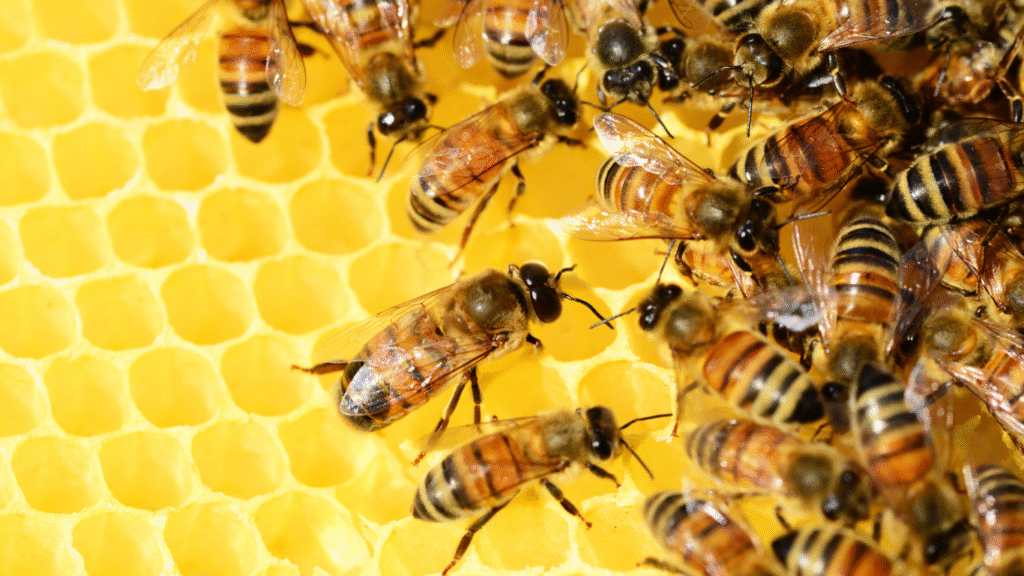Bees are incredible creatures, buzzing around flowers and playing a huge role in our food supply by pollinating crops. From honey to wax, they give us so much, but not all bees are the same. There are thousands of different types of bees, each with unique habits and homes. Whether you’re a gardener, a nature lover, or just curious, understanding the types of bees can make you appreciate these tiny workers even more. In this article, we’ll explore the main kinds of bees, their roles, and what makes each one special. Let’s dive into the buzzing world of bees and discover what makes them so fascinating.
Honey Bees: The Sweet Superstars
Honey bees are probably the first bees you think of, and for good reason—they’re the ones making honey and living in those iconic hives. Found all over the world, they’re social bees that live in colonies with a queen, workers, and drones. Each colony can have up to 80,000 bees, all working together like a tiny city. Workers collect nectar and pollen, drones mate with the queen, and the queen lays eggs to keep the colony going. Honey bees pollinate crops like apples and almonds, making them vital to farmers. Their honey and wax are used in food, candles, and even skincare. But they’re facing challenges like pesticides and habitat loss, so protecting them is key. Next time you see a hive, give these busy bees some love for their hard work.
The Role of the Queen Bee
The queen bee is the heart of the honey bee colony. She’s the only one who lays eggs—up to 2,000 a day! Her job is to keep the colony growing by producing new bees. She releases pheromones to keep the workers organized and calm. Without her, the colony would struggle to survive. Queens live longer than other bees, sometimes up to five years, but they’re replaced if they get weak. Fun fact: a queen’s born from the same eggs as workers but gets special food called royal jelly.
Why Honey Bees Are So Important
Honey bees are superstars for pollination. They visit flowers to gather nectar and pollen, spreading pollen to help plants grow fruits and seeds. About one-third of our food, like fruits, veggies, and nuts, depends on them. They also make honey, a natural sweetener, and beeswax for candles and crafts. But their numbers are dropping due to pesticides, diseases, and fewer flowers. Supporting local beekeepers and planting bee-friendly flowers can help keep these amazing insects thriving.
Bumble Bees: The Fuzzy Pollinators
Bumble bees are the big, fluffy bees you see buzzing loudly in gardens. Their round, fuzzy bodies make them easy to spot, and they come in colors like black, yellow, and orange. Unlike honey bees, bumble bees live in smaller colonies, usually with a few hundred bees. They build nests in the ground, often in old rodent burrows or grassy spots. Bumble bees are amazing pollinators, especially for crops like tomatoes and blueberries, because they use “buzz pollination,” shaking flowers to release pollen. They’re less likely to sting than other bees and are super friendly to humans. Sadly, some bumble bee species are declining due to habitat loss. Planting wildflowers and leaving patches of bare soil can give these gentle giants a home.
How Bumble Bees Pollinate
Bumble bees are pollination pros thanks to their unique buzz pollination technique. They grab onto flowers and vibrate their wings super fast, shaking loose pollen that other bees might miss. This makes them perfect for crops like tomatoes, peppers, and cranberries, which need that extra shake. Their fuzzy bodies also pick up lots of pollen, spreading it as they move from flower to flower. Bumble bees work even in cool or cloudy weather, unlike honey bees, making them reliable pollinators in tougher climates.
Where Bumble Bees Live
Bumble bees like cozy, underground nests, often taking over abandoned mouse burrows or digging small holes in soft soil. Some species nest above ground in thick grass or hollow logs. Their colonies are smaller than honey bee hives, with just 50 to 400 bees. At the end of summer, most of the colony dies, but new queens hibernate underground to start fresh nests in spring. You can help by leaving some bare soil in your yard or avoiding pesticides that harm their homes.
Solitary Bees: The Lone Workers
Not all bees live in big groups—solitary bees prefer to go it alone. These bees, like mason bees and leafcutter bees, don’t have queens or workers. Each female builds her own nest, lays eggs, and gathers food without help. Solitary bees are super diverse, with over 20,000 species worldwide, and they come in all sizes and colors. They nest in places like hollow stems, wood, or soil. Though they don’t make honey, they’re awesome pollinators for gardens and crops. Solitary bees are gentle and rarely sting, making them great neighbors. You can attract them by setting up bee houses or leaving dead wood in your yard.
Mason Bees: The Mud Builders
Mason bees are solitary bees known for using mud to build their nests. They find small holes, like in wood or stems, and create chambers with mud walls to lay their eggs. Each chamber gets pollen and nectar for the baby bees. Mason bees are small, often metallic blue or green, and they’re fantastic pollinators for fruit trees like apples and cherries. They’re active in early spring, so gardeners love them. You can buy or build mason bee houses to give them a place to thrive.
Leafcutter Bees: The Crafty Nesters
Leafcutter bees are named for their habit of cutting neat circles from leaves to line their nests. They use these leaf pieces to create cozy chambers in hollow stems or wood for their eggs. These bees are small, with shiny bodies, and they’re great at pollinating wildflowers and crops like alfalfa. Leafcutter bees work fast, carrying pollen on their fuzzy bellies. They’re gentle and perfect for gardens. Leaving hollow stems or setting up bee hotels can attract these crafty little pollinators to your yard.
Carpenter Bees: The Wood Carvers
Carpenter bees look a bit like bumble bees but with shinier, less fuzzy bodies. They get their name from their love of drilling perfectly round holes into wood to make nests. Unlike social bees, carpenter bees are mostly solitary, though they sometimes share tunnels. Females lay eggs in these wood tunnels, stocking them with pollen for their young. They’re great pollinators for flowers and crops, but their wood-boring can damage decks or fences. To prevent this, paint wood surfaces or offer untreated wood scraps as nesting spots. Carpenter bees are gentle, and males (who can’t sting) often hover curiously near people.
Why Carpenter Bees Drill Wood
Carpenter bees carve tunnels in soft, unpainted wood like cedar or pine to create nests. Females use their strong jaws to chew out chambers where they lay eggs, leaving piles of sawdust below. Each chamber gets a ball of pollen and nectar for the larvae. These tunnels can be reused for years, which is why carpenter bees keep coming back. Painting or sealing wood can discourage them, or you can provide sacrificial wood to keep them away from your porch.
Are Carpenter Bees Harmful?
Carpenter bees aren’t usually harmful to people—they’re gentle, and males don’t even have stingers. But their tunneling can weaken wooden structures over time, like decks or eaves. They’re not as destructive as termites, but repeated nesting can cause issues. On the plus side, they’re excellent pollinators, visiting flowers like eggplants and salvias. To manage them, try sealing wood or setting up bee houses to redirect their nesting while still benefiting from their pollination work.
Stingless Bees: The Gentle Tropics Dwellers
Stingless bees, found mostly in tropical places like South America and Australia, are small, social bees that live in colonies like honey bees. They don’t have stingers, so they defend their nests by biting or using sticky resin. These bees make honey, often called “sugarbag” honey, which is tangy and prized by locals. Their colonies, with a queen and workers, live in hollow trees or logs. Stingless bees pollinate tropical crops like coffee and mangoes, making them vital to farmers. Their honey is used in traditional medicine, too. You can support them by protecting tropical forests where they thrive.
How Stingless Bees Make Honey
Stingless bees collect nectar from flowers, just like honey bees, and store it in small pots made of wax and resin. Their honey is thinner and more tangy than honey bee honey, often with a floral or citrusy taste. In places like Brazil and Australia, people harvest it for food and medicine. The bees seal these pots to keep the honey safe. Because they don’t sting, they’re easier to work with for small-scale beekeepers, but their honey yields are smaller than those of honey bees.
Why Stingless Bees Matter in the Tropics
In tropical regions, stingless bees are key pollinators for plants like cacao, passionfruit, and avocados. Their small size lets them visit tiny flowers that bigger bees might skip. They also help maintain forest ecosystems by pollinating wild plants. Sadly, deforestation and pesticides threaten them. Supporting sustainable farming and preserving forests can protect these bees. Their honey and pollination make them a cultural and ecological treasure in places like Central America and Southeast Asia.
How to Help All Types of Bees
Bees of all kinds—honey, bumble, solitary, carpenter, and stingless—are facing tough times from habitat loss, pesticides, and climate change. You can help by planting bee-friendly flowers like lavender, sunflowers, and clover to give them food. Avoid using pesticides in your garden, and leave some bare soil or dead wood for nesting. Setting up bee houses for solitary bees or supporting local beekeepers also makes a difference. Every small action helps keep these pollinators buzzing, ensuring our crops, flowers, and ecosystems stay healthy.
Creating a Bee-Friendly Garden
A bee-friendly garden is easy to make. Plant native flowers that bloom at different times so bees have food all year. Think sunflowers, bee balm, or wildflowers. Skip chemical pesticides—use natural options like neem oil if needed. Leave patches of bare soil for ground-nesting bees and keep some hollow stems or wood for others. A small water dish with pebbles gives bees a place to drink. Even a tiny yard can become a bee haven with these simple steps.
Supporting Local Beekeepers
Buying honey from local beekeepers helps honey bees and stingless bees. It supports people who care for colonies and fight threats like pests and diseases. Local honey is often tastier and can even help with allergies. You can also join community efforts to plant wildflowers or advocate for pesticide bans. By supporting beekeepers, you’re helping bees stay healthy and keeping our food supply strong. Check farmers’ markets or co-ops for local honey.
Final Thoughts on Types of Bees
Bees come in all shapes and sizes, from honey-making honey bees to wood-drilling carpenter bees. Each type of bee has a unique role in pollinating our crops and flowers, keeping our world green and our plates full. By learning about honey bees, bumble bees, solitary bees, carpenter bees, and stingless bees, you can appreciate their hard work and help protect them. Plant a flower, skip the pesticides, or support a beekeeper—every bit helps. Let’s keep these amazing pollinators buzzing for years to come.



